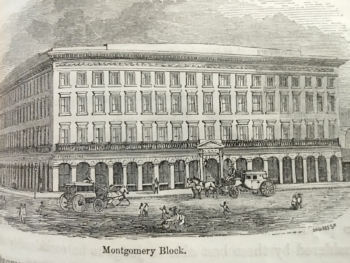Meet the Monkey Block!
The Place Before The Pyramid

After six destructive fires in San Francisco from 1849 to 1852, Henry Wager Halleck hired Gordon Cummings to design a fireproof, four-story building. The Montgomery Block took up the entire block bounded by Washington, Sansome, Merchant, and Montgomery Streets. Just three years before, this block was under water—part of San Francisco Bay— because at that time the bay’s waterline came up to Montgomery Street.
Building such a structure atop bay mud was no small feat. The foundation consisted of tree trunks linked together with iron clamps. The building was constructed atop this “raft.” It had four stories, plus a basement. Its iron frame had walls made of brick and covered with stucco. The outside walls were 36 inches thick; inside walls were 24 inches thick. All the windows had iron shutters to protect against fire. Many people didn’t believe that the building could be fireproof. Some called the venture “Halleck’s folly.”
When it was finished, the Montgomery Block was the largest building in the western United States. Halleck called it the Washington Block, but the name never stuck. Within a few years, the building became known officially as the Montgomery Block, later nicknamed “the Monkey Block.” Offices in the building included major law firms, the Pacific and Atlantic Railroad, U.S. Engineers Corps, the city’s first Stock and Exchange Board, the city’s first Assayer’s Office, the city’s first Law Library, and two of San Francisco’s earliest newspapers: the Alta California and the Daily Herald. One of the most popular businesses was the Bank Exchange—not a financial institution but a popular saloon. One of the Bank Exchange’s last owners, Duncan Nichols, invented San Francisco’s iconic cocktail, Pisco Punch.
In the 1870s, some companies moved their offices closer to Market Street. As Montgomery Block rents went down, artists, performers, and writers—known as “bohemians”—began to move in. Many of these people rented offices and used them as studios and living spaces. Over the years, some of the bohemians associated with the Montgomery Block included Bret Harte, George Sterling (the “King of Bohemia”), Jack London, Samuel Clemens (before becoming Mark Twain), Mary Austin, Gertrude Atherton, and Maynard Dixon. In the 1880s, Adolph Sutro rented many offices to hold his ever-expanding library collection.
In 1906, a catastrophic event proved that Henry Halleck was right about his building. The Montgomery Block remained standing after most buildings in the area were destroyed by the earthquake and subsequent fires. In the 1900s, San Francisco’s economy ebbed and flowed; businesses and bohemians came and went. Yet the building continued to be popular; even in the 1940s and 1950s, there was a long waiting list for rentals.
In 1959, the Montgomery Block was torn down and replaced by a street parking lot. The Transamerica Pyramid was built on part of the site during 1969–1972.
The links below lead to additional information about the Monkey Block.
FoundSF
A fascinating website with great articles about the history of San Francisco.
“From Fish-Choked Mudflat to the Pyramid” by Chris Carlsson
URL: https://www.foundsf.org/index.php?title=From_Fish-Choked_Mudflat_to_the_Pyramid
The Living New Deal
Articles and stories about local history during President Roosevelt’s New Deal
“The New Deal Artists of the Monkey Block” by Harvey Smith
URL: https://livingnewdeal.org/the-new-deal-artists-of-the-monkey-block/
Noe-Hill
An avocational website that explores historic sites and other points of interest in San Francisco, northern California, the American West, and other areas.
“California Historical Landmarks in San Francisco”
URL: https://noehill.com/sf/landmarks/cal0080.asp
Meet Girlina, producer of “Monkey Block: San Francisco’s Golden History,” a history-based podcast that chronologically retells San Francisco’s history, starting in 1776. Here are two of her episodes:
S1 Episode 5, Thompson’s Cove and Yerba Buena’s First Civic Improvement 1840s
In 1838, A.B. Thompson ran a tannery that was uncovered during a 2006–2013 Zooarchaeological study. This episode discusses A. B. Thompson, the Zooarchaeological study, and San Francisco’s first civic improvement: an 1844 footbridge.
URL: https://www.buzzsprout.com/1646416/8845779
S2 Episode 3, Yerba Buena’s Original Shoreline and Development
This episode discusses the history behind San Francisco’s original shoreline, rancho versus pueblo land, the creation of water lots, and how we changed the original shoreline and tidelands.
URL: https://www.buzzsprout.com/1646416/9853241
Want Even More Monkey Business?
Lorri Ungaretti will give a two-hour mini course on the Montgomery Block on Thursday, January 16, 2025, from 1:30 to 3:30 pm at 160 Spear Street in San Francisco. The mini course is sponsored by OLLI (Osher Lifelong Learning Institute) and the fee is $29. If you are interested, send an email to [email protected].
